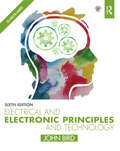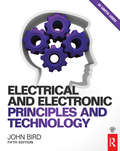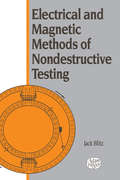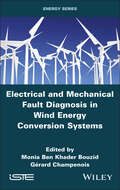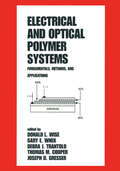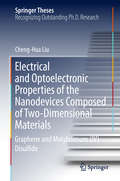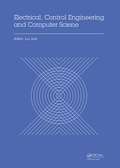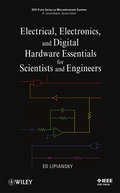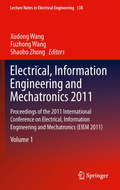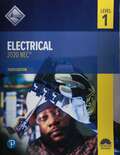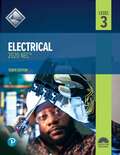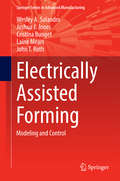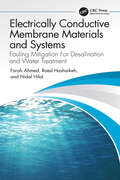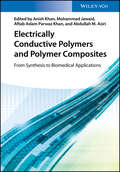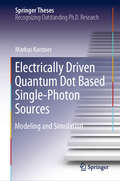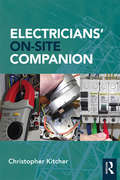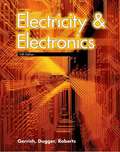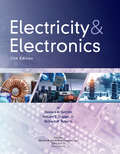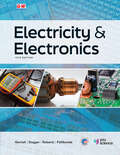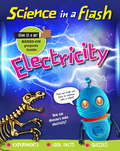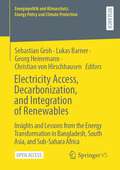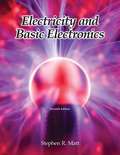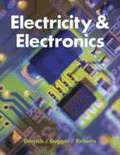- Table View
- List View
Electrical and Electronic Principles and Technology
by John BirdThis practical resource introduces electrical and electronic principles and technology covering theory through detailed examples, enabling students to develop a sound understanding of the knowledge required by technicians in fields such as electrical engineering, electronics and telecommunications. No previous background in engineering is assumed, making this an ideal text for vocational courses at Levels 2 and 3, foundation degrees and introductory courses for undergraduates.
Electrical and Electronic Principles and Technology, 5th ed
by John BirdThis much-loved textbook introduces electrical and electronic principles and technology to students who are new to the subject. Real-world situations and engineering examples put the theory into context. The inclusion of worked problems with solutions really help aid your understanding and further problems then allow you to test and confirm you have mastered each subject. In total the books contains 410 worked problems, 540 further problems, 340 multiple-choice questions, 455 short-answer questions, and 7 revision tests with answers online. This an ideal text for vocational courses enabling a sound understanding of the knowledge required by technicians in fields such as electrical engineering, electronics and telecommunications. It will also be an excellent refresher for foundation and undergraduate degree students. It is supported by a companion website that contains solutions to the 540 questions in the practice exercises, formulae to help students answer the questions, multiple choice questions linked to each of the 23 chapters and information about the famous mathematicians and scientists mentioned in the book. Lecturers also have access to full solutions and the marking scheme for the 7 revision tests, lesson plans and illustrations from the book.
Electrical and Magnetic Methods of Nondestructive Testing
by Jack BlitzElectrical and Magnetic Methods of Nondestructive Testing presents a comprehensive account of the electrical and magnetic methods of nondestructive testing (NDT). The book begins with a discussion of the requirements for NDT and the criteria for the choice of a given method, followed by a summary of the general theory relating to electrical and magnetic testing techniques. Subsequent chapters discuss specific methods, including eddy current and flux-leakage techniques and microwave and potential drop methods. The appendix provides some useful programs for eddy current impedance analyses. These programs are in BASIC and can be run on PCs.
Electrical and Mechanical Fault Diagnosis in Wind Energy Conversion Systems
by Gérard Champenois Monia Ben Khader BouzidWind energy conversion systems are subject to many different types of faults and therefore fault detection is highly important to ensure reliability and safety. Monitoring systems can help to detect faults before they result in downtime. This book presents efficient methods used to detect electrical and mechanical faults based on electrical signals occurring in the different components of a wind energy conversion system. For example, in a small and high power synchronous generator and multi-phase generator, in the diode bridge rectifier, the gearbox and the sensors. This book also presents a method for keeping the frequency and voltage of the power grid within an allowable range while ensuring the continuity of power supply in the event of a grid fault. Electrical and Mechanical Fault Diagnosis in Wind Energy Conversion Systems presents original results obtained from a variety of research. It will not only be useful as a guideline for the conception of more robust wind turbines systems, but also for engineers monitoring wind turbines and researchers
Electrical and Optical Polymer Systems: Fundamentals: Methods, and Applications (Plastics Engineering)
by Donald L. Wise"Offers background information, methods of characterization, and applications for electrical and optical polymers, including biopolymers, and tutorial sections that explain how to use the techniques."
Electrical and Optoelectronic Properties of the Nanodevices Composed of Two-Dimensional Materials: Graphene and Molybdenum (IV) Disulfide (Springer Theses)
by Cheng-Hua LiuThis thesis focuses on the transport and magneto-transport properties of graphene p-n-p junctions, such as the pronounced quantum Hall effect, a well-defined plateau–plateau transition point, and scaling behavior. In addition, it demonstrates persistent photoconductivity (PPC) in the monolayer MoS2 devices, an effect that can be attributed to random localized potential fluctuations in the devices. Further, it studies scaling behavior at zeroth Landau level and high performance of fractional values of quantum Hall plateaus in these graphene p-n-p devices. Moreover, it demonstrates a unique and efficient means of controlling the PPC effect in monolayer MoS2. This PPC effect may offer novel functionalities for MoS2-based optoelectronic applications in the future.
Electrical, Control Engineering and Computer Science: Proceedings of the 2015 International Conference on Electrical, Control Engineering and Computer Science (ECECS 2015, Hong Kong, 30-31 May 2015)
by Jian LiuElectrical, Control Engineering and Computer Science includes the papers from ECECS2015 (Hong Kong, 30-31 May 2015), which was organized by the American Society of Science and Engineering (ASEE), a non-profit society for engineers and scientists. Presenting new theories, ideas, techniques and experiences related to all aspects of electrical enginee
Electrical, Electronics, and Digital Hardware Essentials for Scientists and Engineers
by Ed LipianskyA practical guide for solving real-world circuit board problems Electrical, Electronics, and Digital Hardware Essentials for Scientists and Engineers arms engineers with the tools they need to test, evaluate, and solve circuit board problems. It explores a wide range of circuit analysis topics, supplementing the material with detailed circuit examples and extensive illustrations. The pros and cons of various methods of analysis, fundamental applications of electronic hardware, and issues in logic design are also thoroughly examined. The author draws on more than twenty-five years of experience in Silicon Valley to present a plethora of troubleshooting techniques readers can use in real-life situations. Plus, he devotes an entire chapter to the design of a small CPU, including all critical elements--the complete machine instruction set, from its execution path to logic implementation and timing analysis, along with power decoupling, resets, and clock considerations. Electrical, Electronics, and Digital Hardware Essentials for Scientists and Engineers covers: Resistors, inductors, and capacitors as well as a variety of analytical methods The elements of magnetism--an often overlooked topic in similar books Time domain and frequency analyses of circuit behavior Numerous electronics, from operational amplifiers to MOSFET transistors Both basic and advanced logic design principles and techniques This remarkable, highly practical book is a must-have resource for solid state circuit engineers, semiconductor designers and engineers, electric circuit testing engineers, and anyone dealing with everyday circuit analysis problems. A solutions manual is available to instructors. Please email ieeeproposals@wiley.com to request the solutions manual. An errata sheet is available.
Electrical, Information Engineering and Mechatronics 2011
by Shaobo Zhong Fuzhong WangAs future generation electrical, information engineering and mechatronics become specialized and fragmented, it is easy to lose sight of the fact that many topics in these areas have common threads and, because of this, advances in one discipline may be transmitted to others. The 2011 International Conference on Electrical, Information Engineering and Mechatronics (EIEM 2011) is the first conference that attempts to follow the above idea of hybridization in electrical, information engineering, mechatronics and applications. This Proceedings of the 2011 International Conference on Electrical, Information Engineering and Mechatronics provides a forum for engineers and scientists to address the most innovative research and development including technical challenges and social, legal, political, and economic issues, and to present and discuss their ideas, results, works in progress and experience on all aspects of electrical, information engineering, mechatronics and applications. Engineers and scientists in academia, industry, and government will find a insights into the solutions that combine ideas from multiple disciplines in order to achieve something more significant than the sum of the individual parts in all aspects of electrical, information engineering, mechatronics and applications.
Electrical, Level 1
by NccerCompletelyupdated to the 2020 NEC®! Features ahighly illustrated design, technical hints and tips from industry experts,review questions and a whole lot more! Key content includes: OccupationalOverview: The Electrical Industry, Safety for Electricians, Introductionto Electrical Circuits, Electrical Theory, Introduction tothe National Electrical Code®, Device Boxes, Hand Bending, Wireways,Raceways and Fittings, Conductors and Cables,Basic Electrical Construction Drawings,Residential Electrical Services, and Electrical TestEquipment.
Electrical, Level 3
by NccerCompletelyupdated to the 2020 NEC®! Features a highly illustrated design,technical hints and tips from industry experts, review questions and a wholelot more! Key content includes: Load Calculations ― Branch and Feeder Circuits,Conductor Selection and Calculations, Practical Applications of Lighting,Hazardous Locations, Overcurrent Protection, Distribution Equipment,Transformers, Commercial Electrical Services, Motor Calculations,Voice, Data, and Video, and Motor Controls.
Electrically Assisted Forming
by Wesley A. Salandro Joshua J. Jones Cristina Bunget Laine Mears John T. RothMaximizing reader insights into the latest research findings and applications of Electrically-Assisted Forming (EAF) - whereby metals are formed under an electric current field - this book explains how such a process produces immediate improved formability of metals beyond the extent of thermal softening, and allows metals to be formed to greater elongation with lower mechanical energy as well as allowing for lightweight brittle metals such as magnesium and titanium to be formed without external heating or annealing, enabling the more effective use of these lightweight metals in design. Including case studies that illustrate and support the theoretical content and real-world applications of the techniques discussed, this book also serves to enrich readers understanding of the underlying theories that influence electro-plastic behaviour. The authors have extensive experience in studying Electrically-Assisted Forming and have written extensively with publications including experimental works, technical briefs, conference proceedings, journal articles, and analytical models.
Electrically Conductive Membrane Materials and Systems: Fouling Mitigation For Desalination and Water Treatment
by Nidal Hilal Farah Ahmed Raed HashaikehElectrically Conductive Membrane Materials and Systems offers in-depth insight into the transformative role of electrically conductive materials in membrane separation processes for desalination and water treatment. The book focuses on the intelligent design of conductive membranes and systems, fouling and related phenomena, fouling control using electrically conductive materials, and electrically tunable membrane systems for microfiltration, ultrafiltration, nanofiltration, reverse osmosis, and membrane distillation. With rising concerns around inaccessibility to freshwater and the ever increasing threats of population growth, climate change, and urban development, the book brings electrically conducting materials to the forefront of membrane separation technology with an emphasis on their role in the mitigation of fouling and related phenomena. Electrically conducting materials expand the versatility of membrane technology and ultimately improve access to safe water. The book is important reading for scientists, engineers, entrepreneurs, and enthusiasts from the water industry who seek to familiarize themselves with a groundbreaking area of study within modern desalination and water treatment. • Explores novel membrane materials and systems from preparation methods, materials selection, and their application in monitoring, fouling control, and performance enhancement. • Examines the mechanism of fouling prevention and cleaning in various electrically conductive materials. • Evaluates the scalability of antifouling materials and coatings, as well as electrically enhanced processes for monitoring and control in membrane separation technology. • Assesses advantages and limitations of applying electrically conductive membrane systems to fouling control for specific water treatment applications. • Provides a critical review of scientific literature in the specialized area of electrical conductive materials and systems for membrane technology.
Electrically Conductive Polymers and Polymer Composites: From Synthesis to Biomedical Applications
by Mohammad Jawaid Abdullah M. Asiri Anish Khan Aftab Aslam KhanA comprehensive and up-to-date overview of the latest research trends in conductive polymers and polymer hybrids, summarizing recent achievements. The book begins by introducing conductive polymer materials and their classification, while subsequent chapters discuss the various syntheses, resulting properties and up-scaling as well as the important applications in biomedical and biotechnological fields, including biosensors and biodevices. The whole is rounded off by a look at future technological advances. The result is a well-structured, essential reference for beginners as well as experienced researchers.
Electrically Driven Quantum Dot Based Single-Photon Sources: Modeling and Simulation (Springer Theses)
by Markus KantnerSemiconductor quantum optics is on the verge of moving from the lab to real world applications. When stepping from basic research to new technologies, device engineers will need new simulation tools for the design and optimization of quantum light sources, which combine classical device physics with cavity quantum electrodynamics. This thesis aims to provide a holistic description of single-photon emitting diodes by bridging the gap between microscopic and macroscopic modeling approaches. The central result is a novel hybrid quantum-classical model system that self-consistently couples semi-classical carrier transport theory with open quantum many-body systems. This allows for a comprehensive description of quantum light emitting diodes on multiple scales: It enables the calculation of the quantum optical figures of merit together with the simulation of the spatially resolved current flow in complex, multi-dimensional semiconductor device geometries out of one box. The hybrid system is shown to be consistent with fundamental laws of (non-)equilibrium thermodynamics and is demonstrated by numerical simulations of realistic devices.
Electricians' On-Site Companion
by Christopher KitcherThis book contains everything electricians need to know about working on site, covering not only the health and safety aspects of site work, but also the techniques and testing knowledge required from the modern-day electrician. Regulations issues are included alongside step-by-step instructions for each task, after which testing information, checklists and example forms are given so that site workers can ensure they have done everything required of them.
Electricidad... ¡Qué fácil!
by Carlos Alberto Fernandes RodriguesCon este libro descubrirás que la electricidad puede ser un juego niños. Este es un libro pensado para ser objeto de consulta e iniciarse en el fabuloso y refulgente mundo de la electricidad. <p><p>Una obra con la que descubrirás que la electricidad puede ser un juego de niños. ¿Te atreves con él?
Electricity & Electronics
by Richard M. Roberts Howard H. Gerrish William E. Dugger Jr.Textbook on the fundamentals for technical school students. No bibliography.
Electricity & Electronics
by Richard M. Roberts Howard H. Gerrish William E. Dugger Mahesh K. PallikondaElectricity & Electronics provides comprehensive coverage of basic concepts and applications in the study of electronics and electrical technology. As students learn the foundational concepts, they also begin developing the skills and knowledge needed to perform laboratory activities. The text correlates to the certifications offered by the Electronics Technicians Association (ETA). Topics include circuitry, motor, generators, power distribution systems, and advanced systems. A chapter covering careers and entrepreneurship make learning relevant to students exploring or preparing for this career.
Electricity (Merit Badge Series)
by Boy Scouts of AmericaThis book introduces scouts to the generation of and uses of electricity.
Electricity (Science in a Flash #23)
by Georgia Amson-BradshawunfortunatelyWhat's the buzz about electricity? All bright sparks need to read this book to discover the shocking facts about electricity, as well as all about batteries, circuits and conductors.This essential KS2 series for children aged 7 and up covers all the key science topics in energetic, quick-fire way, aiding clear comprehension by getting straight to the point! Each spread starts with a 'flash' or headline, summing-up succinctly the science information to follow. Attractive and light-hearted illustration visually conveys the information, adding depth and detail to engage children. Also includes fun jokes and cartoons to keep even the most reluctant readers entertained.
Electricity Access, Decarbonization, and Integration of Renewables: Insights and Lessons from the Energy Transformation in Bangladesh, South Asia, and Sub-Sahara Africa (Energiepolitik und Klimaschutz. Energy Policy and Climate Protection)
by Sebastian Groh Christian Von Hirschhausen Lukas Barner Georg HeinemannThis Open-Access-Book covers different aspects of the low-carbon energy transformation in a unique manner, with a particular focus on two regions, South Asia and Sub-Saharan Africa. The first part of the book provides useful insights on changes and reforms in the energy sector of Bangladesh, while the second part illustrates the low-carbon energy transformation in South Asia and the third part covers lessons from Sub-Saharan Africa. In all of these regions, the energy sector is undergoing major changes, driven by the four D’s: Decarbonization, decentralization, digitization, and democratization. Major overhauls are taking place at all levels: The country level, where energy mixes are rapidly changing, the corporate level, where large state-owned and private companies are challenged and new actors are emerging, and the local level, where technical and regulatory change has made citizen engagement and community power an option to replace or at least complement centralized supply structures.
Electricity And Basic Electronics
by Stephen R. MattElectricity and Basic Electronics teaches basic theory and fundamentals and is a starting point for careers in electronics. The text is clearly written and highly illustrated, making it easy for beginners to understand. Numerous examples walk students step-by-step through circuit analysis where applicable. The Practical Application and Project feature covers topics such as breadboarding, soldering, and reading voltage on an oscilloscope. There are 16 practical applications in all. The Project features, 28 in all, allow students to build items such as a continuity tester, blown fuse indicator, and power supply. Projects typically include a schematic, a picture of the finished product, and a procedure for assembling the project. A new Math Focus feature provides students with a quick review of the basic math skills they need to understand the topic at hand. Math topics covered are exponents, scientific notation, metric and electrical prefixes, order of operations, algebraic equations, adding fractions, rations and proportions, and square roots. A new chapter called “Energy Conservation” covers ways to conserve energy and alternative forms of energy. Geothermal systems, photovoltaics, and wind turbines are just some of the topics covered.
Electricity And Electronics
by Richard M. Roberts Howard H. Gerrish William DuggerTextbook on the fundamentals for technical school students. No bibliography.
